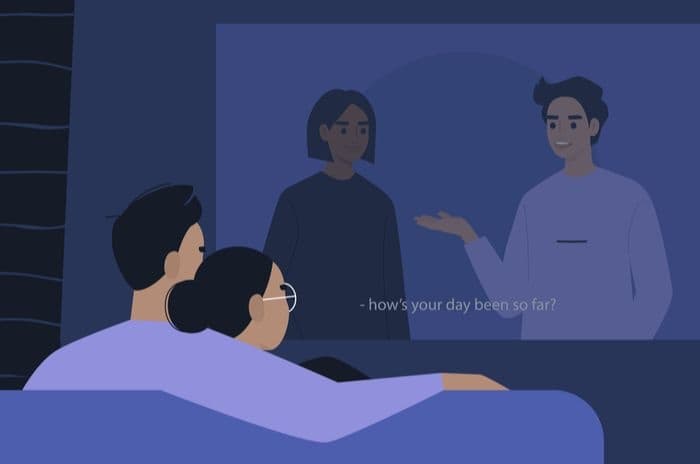Pay TV providers and on-demand platforms have certain requirements they need to make to ensure their content is accessible to people who are hard of hearing or vision impaired.
This includes accessible menus and TV guides, as well as helping users to find content with accessibility features like subtitling or audio descriptions.
Live broadcast channels are also required to provide subtitles, audio descriptions and sign language on a proportion of content too.

How accessible is UK TV?
Ofcom regulates all live broadcast TV channels in the UK and some on-demand services to ensure they're providing additional features to allow hearing and visually impaired customers to access the content.
This covers subtitling, sign language, and audio description services, which broadcasters are required to meet certain obligations for.
For 2025, Ofcom has added 11 new channels to a total of 82 channels, required to meet the Level 1, full requirement, obligations, which are:
- 5% of programmes must have in-vision signing,
- 10% must carry audio description (BBC, ITV, Channel 4 and Sky meet 20%), and
- 80% must be subtitled (90% for ITV & Channel 4, and 100% for BBC).
Full requirement is obligated by any channel that's been on air for 10 years or more, and includes BBC, ITV, Channel 4, Channel 5, Sky channels, TNT Sports, and a number of channels from Discovery.
In April 2024, Ofcom also updated its guidance on Accessibility Services to include, for the first time, video on-demand providers, including ITVX and Channel 4, and subscription services like NOW and Amazon Prime Video.
This guidance covers the production of content as well as how, for example, on-demand platforms are built and designed, with accessibility features like speech volume and text size controls. And of course, how easy it is for customers to find and turn on subtitles or audio descriptions.
Pay TV providers are also required to make sure their TV guides, or Electronic Programming Guides (EPGs) are accessible as well. The EPG code requires Freeview and Freesat, Sky, Virgin Media and YouView to ensure their guides offer:
- 'text to speech' functionality;
- highlighting or filtering of content with audio description or signing;
- text magnification;
- high-contrast displays.
While Freeview, Virgin Media and Sky all meet the required accessibility features, Freesat only offers highlighting/filtering of content and high-contrast displays, while YouView (including the BT TV Box Pro) only offers magnification and high-contrast displays.
Best TV service for the hard of hearing
Sky and Virgin Media set-top boxes offer more accessibility features than BT's YouView powered box.
| Text to speech | Highlighting/filtering | Text Magnification | High-contrast displays | |
|---|---|---|---|---|
| Sky Q | Yes | Yes | Yes | Yes |
| Sky Stream | Yes | Yes | No | Yes |
| Virgin Media TV 360 | Yes | Yes | Yes | Yes |
| Virgin Media Stream | Yes | Yes | Yes | Yes |
| BT TV | No | No | Yes | Yes |
Virgin Media and Sky box-sets provide high levels of accessibility, while Sky also provide Q users with an Easy Grip remote control too if they need one.
BT TV lags behind a little, with their YouView powered box currently missing out on text to speech, and while users can turn subtitles on for all content, there isn't currently a way to highlight or filter programmes by those which have accessibility features, like subtitles.
Android and iOS devices, like TalkTalk's TV Hub, aren't regulated by Ofcom, but they do benefit from Android's 'TalkBack' and iOS's 'VoiceOver' services, which say out loud the buttons or menu options hovered over or selected as a user navigates the TV guide and system menu.
While many of the pay TV services in the UK provide access to the same TV channels, so accessibility features should be fairly similar, accessible content on on-demand services is more varied.
For example, Disney+ offer some of the most accessible content, with 31.8% of program hours available with audio description, while over 97% is subtitled. In comparison, Amazon Prime Video falls behind this somewhat, offering only 57% subtitled content, and no audio descriptions at all. NOW also fails to offer audio descriptions, but does subtitle over 89% of content.
Sky TV
Sky TV meets all four accessibility requirements for their EPG on the Sky Q box, with Screen Magnifier being added in August 2024.
The Sky Stream platform on newer Stream Puck boxes and Glass TVs only meets three accessibility requirements so far however, as it doesn't yet have a screen magnifier feature.
On Sky Stream, customers can:
- Permanently turn on audio descriptions or subtitles for all content
- Turn on high contrast picture settings to help reduce background colour and effects
- Turn on Voice Guidance, which speaks out items on the screen as you navigate the TV guide with the remote control
- Highlight programmes in the TV guide which have subtitles, audio description and/or sign language available
- Use voice commands to control Sky TV by speaking into the remote
Turning subtitles on can be completed via the menu guide, as well as by using voice control and saying the command "turn subtitles on".
Sky customers can also access British Sign Language shows by going to the BSL Zone under TV Shows in the guide, or with the BSL Zone player app.
In terms of accessible content, whether or not TV channels or apps have subtitles, audio description or sign language, is independent of the Sky TV platform itself, although many of Sky's premium content channels are also regulated by Ofcom for accessibility.
Looking at the Television access services report for H1 2024, we can see how many programmes had subtitles on Sky's broadcast TV channels:
| Subtitled programme hours per year | Audio description programme hours per year | |
|---|---|---|
| Sky Atlantic | 100% | 63.6% |
| Sky Showcase | 98.1% | 30.5% |
| Sky Max | 100% | 41% |
| Sky Sci-Fi | 100% | 26.5% |
| Sky Witness | 100% | 44.6% |
| Sky Crime | 100% | 34.1% |
| Sky Comedy | 100% | 42.7% |
| Sky Documentaries | 100% | 61.3% |
| Sky Nature | 100% | 33% |
| Sky Mix | 100% | 34% |
| Sky Arts | 100% | 36.4% |
| Sky News | 81.9% | Exempt |
| Sky Cinema Action | 100% | 34% |
| Sky Cinema Family | 100% | 45.6% |
| Sky Cinema Greats | 100% | 36.8% |
| Sky Cinema Premiere | 100% | 56.6% |
| Sky Cinema Select | 100% | 46.2% |
| Sky Cinema Animation | 100% | 35.3% |
| Sky Sports Premier League | 80% | 22.1% |
| Sky Sports Action | 81.3% | 25.5% |
| Sky Sports Cricket | 81.3% | 18.2% |
| Sky Sports F1 | 80% | 28.5% |
| Sky Sports Golf | 81.8% | 16.2% |
| Sky Sports Main Event | 83% | Exempt |
| Sky Sports Mix | 71.1% | 22.4% |
| Sky Sports Arena | 66.6% | 21.6% |
| Sky Sports Football | 72% | 19.5% |
It stands to reason that pre-recorded programmes on channels like Sky Atlantic and Sky Showcase would have better subtitle prevision, compared to channels with more live content like Sky News and Sky Sports, although even here Sky managed to meet the quota required by Ofcom.
Of course, many of these channels are also available on Virgin Media (with the exception of Sky Atlantic), and BT TV through NOW.
For Sky TV customers more directly however, we can also see how accessible the content on Sky's on-demand services are, including Sky on-demand, Sky Kids, and the Sky Go app:
| Subtitled programme hours per year | Audio description programme hours per year | |
|---|---|---|
| Sky Go app | 84.83% | 0% |
| Sky Kids | 74.54% | 0% |
| Sky on-demand | 70.05% | 0% |
| Sky Store | 26.44% | 0% |
This data comes from Ofcom's Television and on-demand programme services report, Jan to Dec 2023.
While Sky performed well for the provision of subtitles across both live broadcast TV and on-demand services, they had no on-demand content with audio description.
Accessibility features, like subtitles, on on-demand services can vary from live broadcast channels as providers have more time to add these features, or alternatively, the on-demand platform fails to provide them despite having been made available on the content.
Virgin Media
Both Virgin Media TV 360 and Stream boxes support all four of Ofcom's requirements for accessibility on their TV guides, including:
- Subtitles can be turned on permanently wherever available
- Audio description can be turned on permanently wherever available
- Highlight programmes with Sign Language in the guide
- High contrast display on the TV guide
- Enlarged TV Guide
- Voiceover guidance to help navigate the TV guide
- Voice commands can navigate the TV guide by speaking into the remote
- The Virgin TV Go app uses Apple 'VoiceOver' or Android 'TalkBack' to provide spoken feedback when navigating the app
While Virgin Media boxes have a wide range of accessibility features both for those hard of hearing, as well as people with vision impairments, their remote control lacks a dedicated button to turn on subtitles or even access the accessibility menu.
It's possible to use voice commands and simply say "Subtitles" to turn on subtitling, but otherwise customers need to press four buttons to navigate to the correct TV menu page and turn them on.
In contrast, Sky offer customers an 'Easy Grip' remote for Sky Q, which has a dedicated subtitles button, while Sky Stream customers also only need to press one button.
Unlike Sky, Virgin Media don't create any original content themselves, so will be reliant on the various broadcasters of the channels customers subscribe to with regards to how many programmes offer subtitling or audio descriptions.
Like Sky, Virgin Media offer customers BSL Zone on the Together and Film 4 channels.
BT TV
BT's latest set-top box the BT TV Box Pro (also known as the EE TV Box Pro) runs on YouView, which so far, only allows customers to change settings on text magnification and high-contrast menu display to improve accessibility.
The accessibility features that are available include:
- Zoom Interact allows customers to magnify the TV guide to increase the size of text and menus
- High contrast colour scheme ensures all text is white on black and removes any gradients and graphical overlays
- Audio feedback tones are available when navigating the menu
- The BT/EE TV Box can be controlled with a UK USB keyboard
- Subtitles can be turned on permanently for all available content
The new BT TV Box Pro remote control doesn't have a dedicated subtitles button, but users only need to press the 'More' button and then go straight to the subtitles menu.
Once subtitles are switched on, all programmes with available subtitles will have them switched on by default. Within the TV guide, programmes with subtitles available will have an [S] icon beside them.
In terms of accessible content, BT primarily make use of NOW Memberships to provide access to premium Sky TV content, while customers can also access apps like Netflix.
| Subtitled programme hours per year | Audio description programme hours per year | Sign-presented programming per month | |
|---|---|---|---|
| NOW | 89.89% | 0% | 0 |
TNT Sports is another big reason to have BT TV, and we can see how accessible these channels and services are from Ofcom's latest data from H1 2024:
| Subtitled programme hours per year | Audio description programme hours per year | Sign-presented programming per month | |
|---|---|---|---|
| TNT Sports 1 | 85.7% | 12.4% | 194 minutes |
| TNT Sports 2 | 86% | 16% | 176 minutes |
| TNT Sports 3 | 81.1% | 16.5% | 184 minutes |
Those who are hard of hearing may prefer subscribing to TNT Sports to watch sports events, including Premier League matches, due to the provision of sign-presented programming alongside subtitles.
In comparison, while Sky Sports achieves its subtitling quota of 80% on average across all channels, Sky contributes financially to the BSLBT and doesn't offer any sign-presented programming themselves.
On-demand apps
As we've mentioned, in April 2024 Ofcom added on-demand video players to its regulation of the accessibility of television and on-demand access services.
While this guidance covers the accessibility of the platform itself, in terms of menus and what's on guides, it also aims to ensure on-demand services support subtitles, audio descriptions, and where possible, sign language on content too.
Ofcom's latest data on on-demand services, published in May 2024, shows the difference in accessible content features between some of the most popular apps:
| Subtitled programme hours per year | Audio description programme hours per year | Sign-presented programme hours per year | |
|---|---|---|---|
| Amazon Prime Video | 57.91% | 0% | 0 |
| Britbox | 99.31% | 4.28% | 0 |
| Channel 4 | 90.35% | 9.76% | 1.81% |
| Disney+ | 97.44% | 31.8% | 0 |
| ITVX | 93.91% | 12.46% | 1.13% |
| My5 | 73.11% | 7.02% | 0.02% |
| NOW | 89.89% | 0% | 0 |
Disney+ has the most content with audio description, as well as over 97% of content being subtitled. NOW also does well for subtitling, with over 89% of content subtitled, but lacks any content with audio description at all.
Unsurprisingly, the UK's main broadcast apps from ITV, Channel 4 and My5, also have good accessibility, with over 90% of content subtitled, and a range of content with audio description and even sign-presented programming too.
Amazon Prime Video currently fairs the worse, with just 57% of content subtitled and no audio description or sign-presented programming at all.
Summary: Best TV services for subtitles and accessible content
People who are hard of hearing who only need to turn on subtitles to improve their ability to enjoy TV shows, movies and even sporting events, are well catered for, both by live TV channels and on-demand apps.
The development of remote controllers has reduced buttons, and it's often now more complicated to turn on subtitles than it used to be, with older Sky and Virgin V6 remotes hosting a dedicated subtitles button.
However, it's possible to turn subtitles (and/or audio description) on permanently on all of the TV platforms we looked at, so once set up users shouldn't find this an on-going problem.
Sky and Virgin Media both meet Ofcom's requirements for an accessible TV menu, while Disney+ and ITV are some of the most accessible on-demand apps in terms of content accessibility features like subtitling and audio descriptions.
Sign-presented programming is generally lacking on both broadcast TV and on-demand content, with many broadcasters, such as Sky, choosing to contribute to BSLBT instead of adding signed features to their own content. While this funds content on BSL Zone and the BSL Zone player app, some may find this isn't as inclusive as it should be.
Overall, UK TV has good levels of accessibility, especially for those with hearing impairments, however, new regulation of on-demand apps and the upcoming Media Bill, will continue to strengthen this, with Netflix also soon becoming required to meet certain levels of accessibility, such as subtitling.









Comments